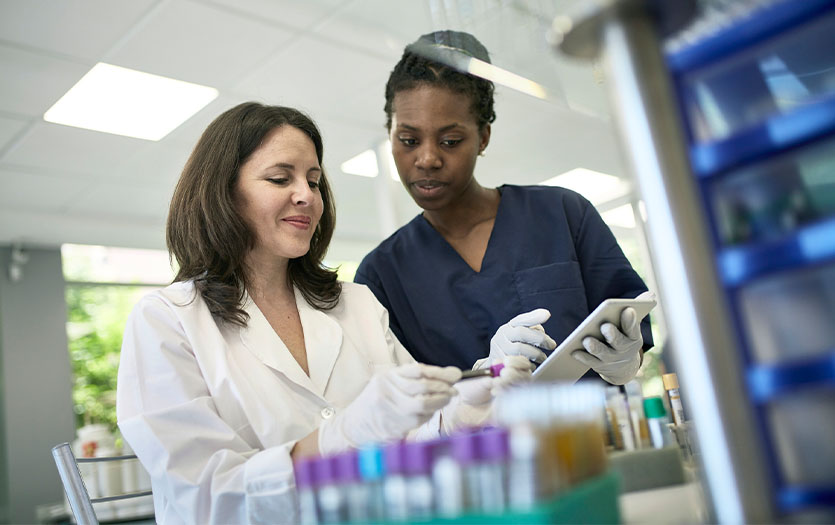
This post was written by Lauren Killion, MBA, RDN, LD; Molly Burns, MS, RDN, LD; Alison Johnson, MS, RDN, LD; and Ciersten Deardorf, MS, RDN, CSO, LD.
Cancer treatments put a lot of stress on the body, and having a well-balanced diet that provides adequate nutrition is crucial. This ensures the body has what it needs to recover from the side effects these therapies can cause and promotes the successful completion of treatments, therefore improving quality of life.
How can the summer season support better nutrition for cancer recovery?
Summer is the best time to purchase many different fruits and vegetables from the grocery store or local farm stands and farmers' markets. Many fruits and vegetables are "in season" during this time, so the taste and availability can't be beaten!
When you include a variety of fruits and vegetables, you are not only ramping up your immune system with antioxidants, but you are also adding many different phytochemicals to your diet, which are known to help reduce cancer cell growth and reduce the risk of recurrence.
Which summer fruits and vegetables are especially good for boosting immunity?
Vitamin C helps support the immune system and fight infections. Berries, watermelon, mango, pineapple, tomatoes and oranges are all fresh summer fruits with high amounts of vitamin C. Vegetables like cucumbers, carrots, bell peppers and leafy greens are also excellent sources of vitamin C.
Other micronutrients essential for boosting your immune function include:
-
Iron - red meat, leafy greens, beans, nuts and fortified cereals
-
Vitamin A - leafy green vegetables, tomatoes, cantaloupe, milk, eggs and fish oils
-
Vitamin D - fortified dairy, salmon, egg yolks, tuna fish and beef liver
-
Vitamin E - wheat germ, sunflower seeds, peanut butter, pumpkin, bell pepper and leafy greens
-
Zinc - milk, nuts, meats, seeds, whole grains and poultry
Are there specific nutrients in summer produce that aid healing or reduce inflammation?
Summer produce offers a wide range of nutrients that can reduce inflammation in the body. Each color provides a different phytochemical that can protect cells and aid in healing.
For example, purple and red fruits and vegetables, such as berries, grapes and plums, contain polyphenols. Yellow and orange fruits, such as carrots, cantaloupe, nectarines and peaches, contain flavonoids and carotenoids. These neutralize free radicals in the body, which can cause chronic inflammation and turn into damaged cells.
Throughout the summer, focus on a variety of berries, melons, peppers, tomatoes, cherries, eggplant, zucchini, green beans, okra, peaches and plums. These are some of the most common in-season fruits and vegetables that will help your body reduce inflammation.
What are some easy ways to incorporate more seasonal foods into daily meals?
Here are some examples of how fruits and vegetables can be turned into breakfast, lunch or dinner.
Breakfast: Berry Yogurt Parfait
Layer yogurt with your favorite summer berries, such as strawberries, blueberries and raspberries. Then sprinkle with granola, nuts or your other favorite toppings.
Lunch: Summer Salad with Grilled Chicken or Chickpeas
Create a base of leafy greens and add sliced cucumbers, bell peppers, tomatoes, and grilled corn kernels. For protein, add grilled chicken or chickpeas. Finish with a dressing of your choice.
Dinner: Stuffed Bell Peppers
Fill halved bell peppers with a mixture of cooked quinoa or rice, lean ground meat or beans, diced tomatoes, corn and spices. Sprinkle shredded cheese on top, then bake until the peppers are tender.
How can patients manage appetite changes or treatment-related nausea in the summer heat?
Eating small, frequent meals and snacks throughout the day rather than one or two large meals can help combat decreased appetite and nausea. It is less work for your body to do when you are not feeling up to eating. Some people find cold foods easier to tolerate when nauseated, which can also be a plus in the summer heat.
Some nourishing go-to snacks could include:
-
Peanut butter toast
-
Cheese and crackers
-
Cottage cheese and fruit
-
Smoothies
-
Fresh fruit with yogurt
-
Fresh vegetables with hummus
-
Celery and peanut butter
-
Tortilla chips and guacamole
-
Popcorn
-
Protein oatmeal balls
-
Mini tomato, mozzarella and basil skewers
Maintaining hydration is also very important while undergoing treatment and when experiencing nausea in the summer heat. Drinking nutrition supplement shakes or smoothies can be a great way to prevent dehydration and obtain essential nutrients. Other great hydration options include:
-
Plain water
-
Fruit or herb-infused water
-
Diluted fruit juices
-
Milk
-
Gatorade or other electrolyte drinks
-
Popsicles
How can grilling or summer cooking styles be adapted for healthier, cancer-friendly meals?
Grilling is a way to add a wider variety of cancer-fighting fruits and vegetables to the meal. Some popular grilled produce items to add to your menu include zucchini, peppers, mushrooms, eggplant, onion, corn, pineapple and peaches.
When it comes to meat, the key is to avoid charring and high heat temperatures for too long. Charring meat, especially red and processed meats, creates harmful compounds that have been linked to increased inflammation and cancer risk. To help reduce exposure to these harmful compounds, you can:
-
Marinate meats for at least 30 minutes using olive oil and garlic, for example.
-
Trim excess fat and use a drip pan, foil or grill mat to help prevent fats and juices from overflowing onto the flame and reducing direct contact with smoke.
-
Pre- or par-cook (partially cook) meats using a microwave, slow cooker, stovetop, oven, or sous vide right before grilling to minimize high heat exposure.
Note: Do not partially cook meats in advance to finish at a later time, as this increases the risk of foodborne illness. Always make sure food is cooked to the appropriate internal temperature before serving.
What are some red flags or foods to avoid, even if they're seasonal?
The American Institute for Cancer Research recommends limiting red meats (beef, pork, lamb) and processed meats (bacon, deli meat, hot dogs, brats, smoked meats) to 12-18 oz per week.
Research shows that consuming high amounts of heme iron from red meats, especially when cooked using high-temperature methods, can cause damage and inflammation in the body. Over time, this may increase the risk of developing certain cancers, including colorectal cancer. As mentioned above, the key is to avoid charring the meat. The literature also shows that processing meat increases the risk of damage and inflammation. It is all about moderation and too much of any food item is not healthy for the body.
While most seasonal produce is safe to eat while undergoing cancer treatment, it's important to take extra precautions, especially if your immune system is compromised. Fruits and vegetables that have not been washed can carry bacteria and parasites, which may lead to infections. Some berries with numerous crevices and leafy greens that grow in layers can be difficult to clean and may need to be avoided if you have a high risk of infection.
Should patients consult a dietitian before making drastic dietary changes during recovery?
Meeting with a registered dietitian before making any dietary change can ensure the body is receiving adequate nutrition to aid recovery and prevent deficiencies. Parkview Packnett Family Cancer Institute registered dietitians specialize in oncology nutrition and can provide individualized plans to help patients meet their nutrition goals.



